<% ns_puts [mkm_getnavbar] %>

Advanced Tennis:
Sampras Second Serve
by John Yandell
Page 2
As a result of this change in the path of the racquet, the followthrough also changes somewhat. Instead of finishing with the palm of the hand in line with the left leg, the racquet hand sometimes moves across the body less, finishing more in line with the nearer right leg or even at times, fully on his right side.
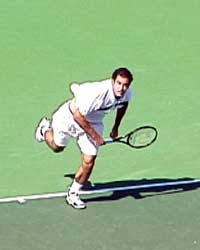 |
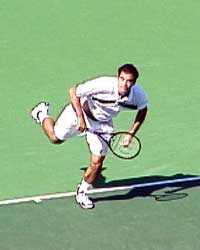 |
On the second serve (right) Pete’s finish is usually not as far to his left or across his body, ending in line with his right leg or even to the right of his body. This is the natural result of the changes in the motion. His hitting arm stays very relaxed finding the finish position automatically. |
|
This change means the pronation after the hit is also increased. But what is key is that this is a natural consequence of the different toss and the different contact point.
In the animations, note how totally relaxed his arm is on the second delivery. Some players make the mistake of trying to force this pronation instead of simply allowing it to happen. The result is probably a loss of speed and also, the possible risk of muscle or joint injury.
Compared to his first serve, Pete is hitting up to
twice as much spin on his second ball. You may not have the racquet head speed to generate 5000rpm, but this same ratio—roughly twice as
much spin or a little less than twice as much spin on the second ball—is
a good starting point for players trying to model their own speed/spin
combinations after Pete. No doubt creating the right levels of spin
and speed are a key to Pete’s serving effectiveness and can be for you
as well.
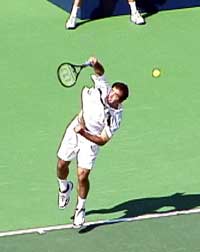 |
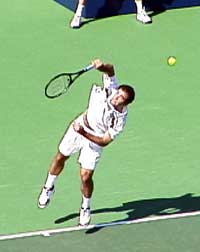 |
As with the followthrough, the more extreme pronation on the second serve (right) is the result rather than the cause of the changes in the toss and in the “high five” motion to the ball, which now comes more from the left. |
|
But, beyond this analysis, there may be an additional, hidden secret in Pete’s use of spin, a secret that goes to the underlying physics of the sport, something that has never been recognized or studied at the pro level.
Preliminary results from new Advanced Tennis analysis
indicate that Pete’s use of spin may actually create a kind of
“multiplier effect” when the ball hits the court. Certain spin levels seem literally to change the way the ball bounces off the
court in a way that makes the ball faster after the bounce than a ball hit
with the same speed but less spin.
Advanced Tennis principal scientist Nasif Iskander is
studying the complex interrelationships between speed and spin in pro
tennis, and how, in particular, speed and spin interact at the moment of
the bounce.
Preliminary analysis reveals something startling: a
second serve hit with heavy spin may actually conserve more speed and come
off the court faster than a second serve with less spin, but hit at the
same identical speed.
This line of inquiry may in turn explain one of the
most interesting (if unfortunately briefest) moments in the hundreds of
hours of cable and network coverage of the U.S. Open.
|
After Sampras defeated Lleyton Hewitt in the
semifinals, Pat McEnroe analyzed two second serves, one from Sampras and
one from Hewitt, based on data being collected on site by Lucent
Technology researchers. Both serves left the racquet at virtually the
same speed, Pete’s at 98mph, and Hewitt’s at 97mph. The
startling part was that when both balls reached the receiver, Pete’s
second serve lost far less velocity than Hewitt’s. After the
bounce, Pete’s serve was still traveling at 67mph, while Hewitt’s had
slowed to about 52mph.
How is that possible? How could one serve slow down more than other if they had the same initial speed? Doesn’t that defy the laws of physics? Isn’t the friction from the air resistance and from the bounce on the court a constant force that would affect both balls in the same way?
One possible explanation is that the balls measured
by Lucent had flight paths with different trajectories and lengths. Pete’s serve was hit to the backhand in the ad court and bounced well
inside the service line. Hewitt’s was hit wide in the deuce court and
landed almost dead in the corner.
But could these factors really account for the speed difference? Advanced Tennis Research indicates that there was another possible factor at work - the effect that spin has on the change in speed of the ball at the bounce (www.AdvancedTennis.com).
Nasif Iskander’s analysis appears to indicate at least at some speeds, higher spin levels may cause the ball to slow down less. This means heavy spin on serves at certain speeds may result in a higher effective speed after the bounce, and therefore at the critical moment when the receiver must actually strike the return.
Although the Lucent researchers were not recording
the spin of the balls, it is very likely that Pete’s ball was spinning
at 4500rpm or more, and Hewitt’s substantially less. This is
particularly likely as Hewitt’s serve was hit wide in the deuce court, a
serve that typically spins more slowly than the type of kick serve Pete
hit to the backhand in the ad court.
In and of itself, this heavy spin translates into a heavier ball for the receiver. The ball simply has more initial energy due to its combination of both speed and rotation.
|
|
Only further detailed analysis can answer this
question with any certainty, but the possible implication is startling. Speed may not be an absolute variable in pro tennis.
It’s possible
that a serve hit by Sampras at the exact same speed as other servers could
get to the receiver sooner because of the incredible initial level of spin
on his delivery. Spin makes Pete’s serve heavier. It may also
actually make it faster.
Imagine the effect from the point of view of the
receiver. As tour pros, players are used to reading the speed of the
ball (as well as the location) as it comes off the racquet. What if,
playing Pete, this fine tuned sensory ability to anticipate the speed and
timing of the return was suddenly thrown off? What if Pete possessed the
ability to generate a serve that simply doesn’t behave like other
serves?
So far the results raise more questions than they
answer. What is the effective speed or the “delivery speed” of
Pete’s serve versus the other serves in pro tennis? What does this
relationship between speed and spin mean on the other shots in the game? How does the data bear on the raging discussion among teachers, coaches,
and players on the value of spin and how much spin to teach young players?
Stay tuned. These are just some of the puzzles Advanced Tennis researchers plan to pursue over the next few years. Doing this series on Pete’s serve has been a blast, and I want to thank all the great TennisONE visitors who wrote in with comments and questions. In the coming year watch for more analysis of the strokes of top pros and how you can use them as models for taking your own game to the next level.
Your comments are welcome. Let us know what you think about John Yandell's article by emailing us here at TennisONE.
|
To view the complete ProStrokes Gallery of digitally mastered Pete Sampras serves, click here.
For more information on John Yandell's Advanced Tennis Research Project, click here.
Last Updated 12/15/00. To contact us, please email to: webmaster@tennisone.com
TennisONE is a registered trademark of TennisONE and SportsWeb ONE; Copyright 1995. All rights reserved.

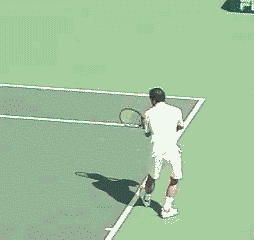
 Visual
Tennis
Visual
Tennis